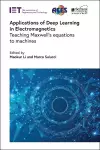
Applications of Deep Learning in Electromagnetics
2 contributors - Hardback
£125.00
Maokun Li (senior member, IEEE) is an associate professor in the Department of Electronic Engineering at Tsinghua University, Beijing, China. He received his BS degree in electronic engineering from Tsinghua University, Beijing, China, in 2002, and his MS and PhD degrees in electrical engineering from University of Illinois at Urbana-Champaign in 2004 and 2007, respectively. After graduation, he worked in Schlumberger-Doll Research as a research scientist before he joined Tsinghua University in 2014. Marco Salucci (senior member, IEEE) received an MS degree in Telecommunication Engineering from the University of Trento, Italy, in 2011, and his PhD degree from the International Doctoral School in Information and Communication Technology of Trento in 2014. He was a postdoctoral researcher at CentraleSupélec, in Paris, France, and then at the Commissariat à l'Énergie Atomique et aux Énergies Alternatives (CEA), in France. He is currently an assistant professor at the Department of Civil, Environmental, and Mechanical Engineering (DICAM) at the University of Trento, and a Research Fellow of the ELEDIA Research Center. Dr Salucci is a member of the IEEE Antennas and Propagation Society and he was a member of the COST Action TU1208 "Civil Engineering Applications of Ground Penetrating Radar." He is the associate editor for communications and memberships of the IEEE Transactions on Antennas and Propagation. Moreover, he serves as an associate editor of the IEEE Transactions on Antennas and Propagation and of the IEEE Open Journal of Antennas and Propagation, and as a reviewer for different international journals including IEEE Transactions on Antennas and Propagation, IEEE Transactions on Microwave Theory and Techniques, IEEE Journal on Multiscale and Multiphysics Computational Techniques, and IET Microwaves, Antennas & Propagation. His research activities are mainly concerned with inverse scattering, biomedical and GPR microwave imaging techniques, antenna synthesis, and computational electromagnetics with focus on system-by-design methodologies integrating optimization techniques and artificial intelligence for real-world applications.